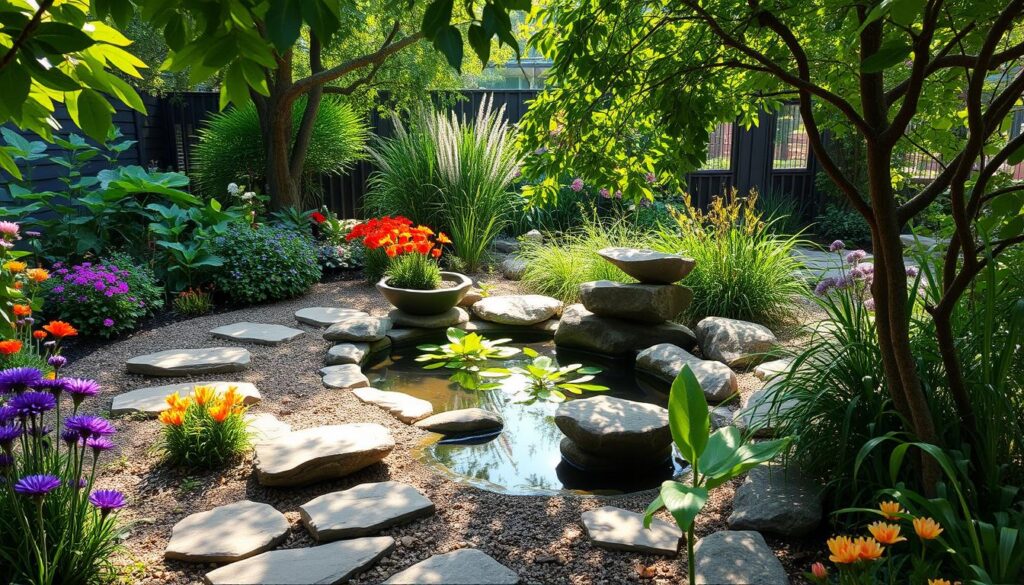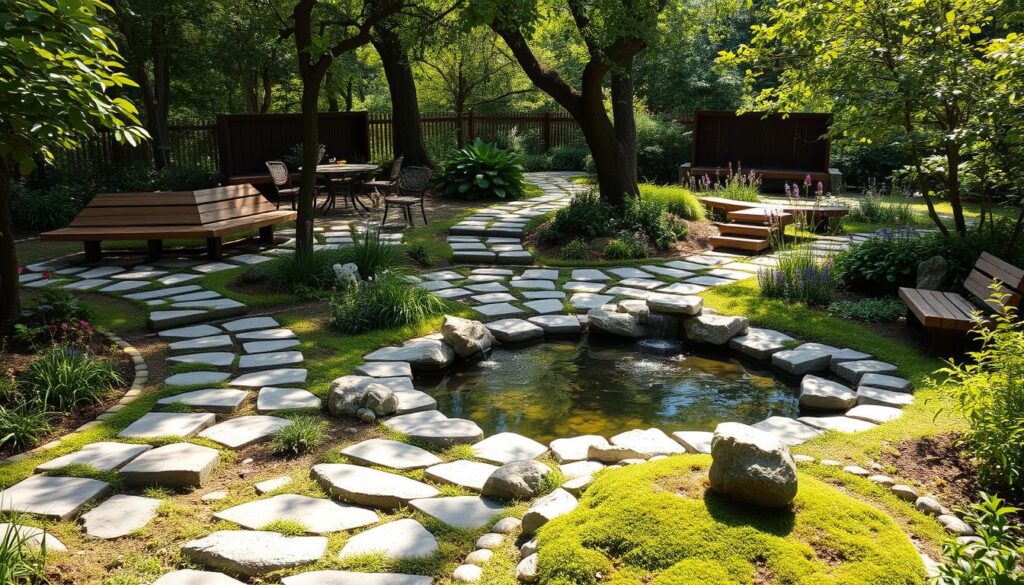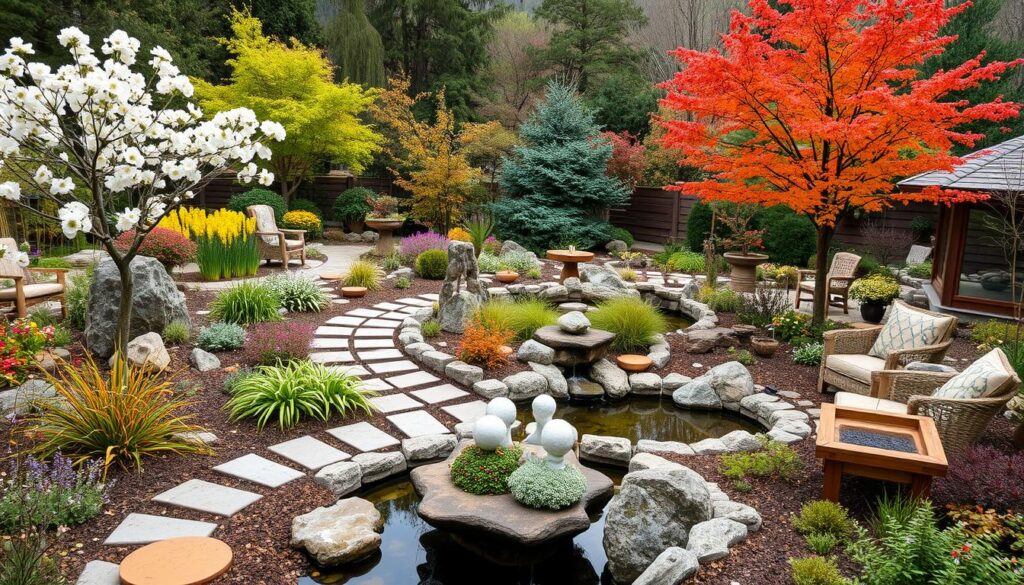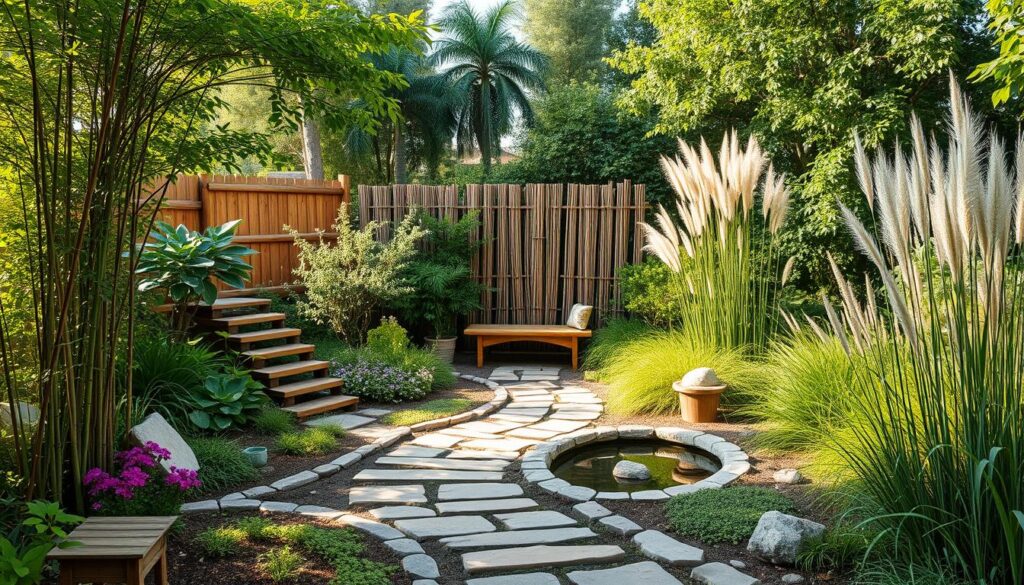The first time I stepped into a permaculture meditation space, something magical happened. The gentle rustle of leaves and the soft earth beneath my feet were amazing. The design of these spaces created an instant connection between my inner world and nature.
Permaculture meditation spaces are more than beautiful gardens. They are a deep approach to healing and growth. These spaces blend nature’s wisdom with mental wellness, creating places that care for both our minds and the earth.
Since the 1970s, permaculture has changed how we see nature. By adding sustainable meditation spaces to gardens, we find ways to reduce stress and grow personally. These spaces help us connect with nature and find peace.
Studies show these spaces have big benefits. People who spend time in permaculture gardens see up to 30% less anxiety and depression. This shows how design and nature can heal our minds, turning gardens into places of healing.
Key Takeaways
- Permaculture meditation spaces combine ecological design with mental wellness
- Gardens can significantly reduce stress and improve mental health
- Sustainable design principles create holistic healing environments
- Meditation in nature enhances personal connection and ecological awareness
- Permaculture offers flexible approaches to creating mindful outdoor spaces
Understanding Permaculture Principles
Permaculture is a way to design spaces that are good for both people and nature. It started in the 1970s by Australian ecologists. This approach helps create gardens that support both people and the environment.
The Ethics of Permaculture
Permaculture is based on three main ethics for sustainable design:
- Earth Care: Protecting and regenerating natural systems
- People Care: Supporting human well-being and community
- Future Care: Ensuring sustainable practices for generations
“Permaculture is a design approach that creates sustainable, self-maintaining systems that meet human needs while supporting ecological balance.”
Key Design Principles
To make mindfulness gardens, we use permaculture design principles. These principles help create harmony with nature. They include:
- Observe and interact with natural environments
- Catch and store energy from natural sources
- Obtain a sustainable yield
- Apply self-regulation and accept feedback
Importance of Biodiversity
Biodiversity is key in eco-friendly meditation areas. Studies show diverse ecosystems are resilient and healing. By using native plants and complex ecological interactions, gardens become dynamic spaces.
Community gardens and urban permaculture projects show how these principles can change spaces. For example, Charm City Farms turned vacant lots into thriving community gardens.
The Benefits of Meditation in Nature
Regenerative meditation sanctuaries help people connect with nature for better mental health. Holistic nature retreats let us see how meditation in the outdoors changes us.

Science shows big benefits of meditating outside. Being in green spaces can cut stress by up to 30%.
Stress Reduction and Mental Clarity
Meditating outdoors has many mental health perks:
- Lowered stress hormone levels
- Improved mental clarity
- Enhanced immune system function
- Mood elevation
“Nature itself is the best physician” – Hippocrates
Connection to the Environment
Meditating in nature makes us more aware. Research shows 63% of people feel more mindful in nature.
Enhancing Mindfulness Practices
Holistic nature retreats offer deep experiences. They help us use our senses to improve meditation. This way, we:
- Become more aware of the present
- Feel closer to nature
- Feel less anxious and depressed
Meditation and nature together are a strong way to improve ourselves and the planet.
Selecting the Right Location
Creating green tranquility zones needs careful thought and planning. Permaculture design says it’s key to know your landscape before making changes. It’s wise to watch a piece of land through all four seasons to understand its unique traits and natural rhythms.
Choosing the right spot for conscious outdoor spaces involves several important factors:
Understanding Sunlight and Microclimates
Sunlight greatly affects your meditation space. Different parts of your landscape have unique microclimates. These microclimates offer:
- Sheltered areas with little wind
- Spots with the right amount of sun
- Natural temperature changes
Water Source Considerations
Being close to water sources can make your meditation space more enjoyable. Keyline design principles help place water elements for a peaceful setting.
Leveraging Natural Landscape Features
Existing landscape features can be used to create meditative spaces. Rock formations, gentle slopes, and native plants can add to the natural beauty and calmness.
“Nature itself is the best designer of peaceful spaces.”
Elements to Include in Meditation Spaces
Creating meditation spaces in permaculture gardens needs careful thought. You must choose elements that bring peace and connect us with nature. These spaces mix nature’s wisdom with our well-being, making outdoor areas places for reflection and healing.
Seating and Comfort Considerations
Choosing the right seating is key for meditation spaces. Use natural materials like wood, bamboo, or stones. These materials blend well with the environment. Think about these important points:
- Ergonomic designs that support proper posture
- Weather-resistant materials
- Integration with natural landscape contours
Natural Soundscapes
Sound is crucial for peaceful meditation areas. Add natural elements for calming sounds:
| Sound Element | Beneficial Effect |
|---|---|
| Bamboo wind chimes | Gentle, rhythmic sounds |
| Trickling water features | Calming background noise |
| Rustling grasses | Soft, meditative whispers |
Aromatic and Colorful Plants
Choose plants that engage all senses in your meditation spaces. Lavender, rosemary, and chamomile are great for their scent and look:
“In nature, every plant tells a story of healing and connection.”

With the right selection of elements, you can make your outdoor area a peaceful meditation spot. It will care for your mind and the environment.
Designing a Pathway to Serenity
Creating mindful pathways in eco-friendly meditation areas needs careful planning. These paths are more than just routes. They are key parts of mindfulness gardens that lead visitors through a special landscape.
Selecting Sustainable Pathway Materials
Choosing sustainable materials is key for pathways in mindfulness gardens. Here are some eco-friendly options:
- Locally sourced gravel
- Reclaimed wood chips
- Natural stone pavers
- Compressed earth blocks
- Recycled brick fragments
Creating Fluid Movement and Accessibility
Pathway design should focus on natural flow and easy movement. Paths with gentle curves that follow the land’s shape bring peace and invite walking for meditation.
“A well-designed path is a journey of discovery, not just a route from one point to another.”
Integrating Natural Formations
Adding natural elements makes pathways feel more organic. Placing rocks, gentle slopes, and native plants turns a simple path into a meditation experience.
| Pathway Element | Purpose | Ecological Benefit |
|---|---|---|
| Meandering Design | Encourage Mindful Walking | Reduces Soil Compaction |
| Native Plant Borders | Create Visual Interest | Supports Local Ecosystem |
| Natural Stone Markers | Provide Meditation Focal Points | Minimal Environmental Impact |
By designing pathways in eco-friendly meditation areas, you make spaces for reflection and care for the environment.
Seasonal Considerations for Meditation Spaces
Creating meditation sanctuaries needs careful planning for each season. Holistic nature retreats must be designed to match nature’s changes. This helps keep meditation practices consistent all year.

Making meditation spaces weather-friendly makes them strong. By thinking about seasonal changes, you can keep your space welcoming all year.
Adapting to Weather Conditions
- Design sheltered areas for protection during rain or intense sunlight
- Implement wind barriers using strategic plant placements
- Create micro-climate zones within the meditation space
Seasonal Plants for Meditation Gardens
Picking the right plants keeps the senses engaged all year. Using native plants adds beauty and helps local wildlife.
| Season | Recommended Plants | Sensory Experience |
|---|---|---|
| Spring | Lavender, Sage | Soft colors, gentle fragrances |
| Summer | Rosemary, Chamomile | Vibrant greenery, calming scents |
| Autumn | Chrysanthemums, Sedum | Rich colors, textural interest |
| Winter | Evergreen shrubs, Winterberry | Structure, subtle greenery |
Maintaining Year-Round Access
Using permaculture ideas helps keep meditation spaces open all seasons. Ideas include:
- Installing proper drainage systems
- Using elevated pathways
- Creating temporary shelters
*”A well-designed meditation space adapts to nature’s rhythms, not against them.”*
Studies show meditation spaces can relax us by 24% and lower anxiety by 20%. By thinking about the seasons, we can make meditation spaces that are welcoming and change-making all year.
Integrating Water Features
Water turns green tranquility zones into peaceful places for reflection. Creating outdoor spaces that are conscious means adding water elements. These elements calm the mind and help the ecosystem around them.
Studies show water’s deep impact on our minds in nature. Being near water can lower stress levels. It cuts down cortisol, the main stress hormone, a lot.
The Calming Effect of Water
Water has special healing powers in meditation areas:
- Reduces psychological tension
- Promotes deep relaxation
- Enhances sensory experiences
- Creates ambient sound environments
Types of Water Installations
There are many water features for different garden styles:
- Small rock fountains
- Reflecting pools
- Zen water gardens
- Naturalistic stream systems
Wildlife Attraction through Water
Water features draw wildlife to green spaces. They make these areas lively ecosystems. They support local animals and offer a chance to watch them meditatively.
“Water is the driving force of all nature.” – Leonardo da Vinci
Research shows gardens with wildlife can balance nature by up to 30%. They turn meditation spots into lively, living places.
Creating Shelter and Privacy
Designing sustainable meditation spaces needs careful thought about shelter and privacy. Permaculture meditation spaces use natural elements to make cozy, safe spots. These spots help us reflect and connect with nature.

Privacy in these spaces is more than just walls. It’s about making a peaceful ecosystem. This ecosystem should protect us and engage our senses.
Natural Screening Options
Choosing the right plants can help with privacy:
- Native shrubs with dense foliage
- Bamboo for quick vertical screening
- Climbing plants on trellises
- Multilayered vegetation zones
Strategic Plant Placement
Permaculture meditation spaces use smart plant placement for privacy. Designers use knowledge of plants and microclimates. This way, they create hidden spots that feel safe yet connected to nature.
*”In permaculture, every plant serves multiple functions”* – Bill Mollison
Incorporating Small Structures
Small structures add privacy and interest to meditation spaces:
- Living willow structures
- Pergolas with climbing plants
- Woven branch screens
- Earth-sheltered meditation platforms
The aim is to make a cozy, natural space for mindful reflection.
Utilizing Native Plants
Creating eco-friendly meditation areas needs careful plant choice. Native plants are key for sustainable, lively mindfulness gardens. They support local ecosystems and offer a peaceful place for meditation.
Advantages of Native Flora
Native plants are great for meditation spaces. They fit well with local weather, need little care, and use less water. Their hardiness makes them perfect for calm gardens.
- Naturally adapted to local ecosystems
- Low maintenance requirements
- Reduced water consumption
- Enhanced biodiversity support
Local Species for Pollination
Native plants draw in bees, butterflies, and birds. This makes meditation spaces lively and engaging. It also helps keep nature in balance.
| Native Plant Type | Pollinator Attraction | Meditation Space Benefits |
|---|---|---|
| Wildflowers | High | Colorful visual experience |
| Native Grasses | Medium | Soft sound and movement |
| Native Shrubs | Medium-High | Natural screening |
Enhancing Diversity in Meditation Spaces
Diverse native plants turn meditation areas into living ecosystems. Careful plant choice creates a space that engages all senses. It offers beauty, sounds, and connects us to nature.
“In nature, nothing is perfect and everything is perfect.” – Alice Walker
Choosing native plants makes meditation gardens more than just places to think. They help local nature and improve our well-being.
Enhancing the Sensory Experience
Creating regenerative meditation sanctuaries means making a space that touches all senses. Holistic nature retreats turn simple gardens into places that heal the mind and heart.
Designing mindful spaces is all about using our senses. Studies show that being in nature can make us feel better and less stressed right away.
Incorporating Textures and Colors
Our sensory journey starts with colors and textures. Each color has its own emotional effect:
- Green: Healing and balance
- Blue: Trust and tranquility
- Purple: Wisdom and reflection
“Colors speak a language deeper than words, communicating directly with our emotional landscape.”
Designing for Sound and Silence
Natural sounds are key in meditation areas. The right sounds can calm us, with studies showing a 25% drop in stress when we hear peaceful sounds.
Seasonal Variations in Sensory Input
Every season brings new sights and sounds. From spring’s colors to autumn’s textures, these spaces can change and inspire us all year.
By carefully adding these sensory elements, we can make spaces that help us grow and find peace.
Community Involvement in Design
Creating green tranquility zones is a team effort. Conscious outdoor spaces flourish when the community is involved in design and upkeep.
Permaculture gardens are places where people work together. They turn into learning spaces that bring people together for environmental care.
Engaging Local Groups
Good meditation garden designs come from working with the community. Local groups add different views and skills to the project:
- Environmental education centers
- Neighborhood wellness associations
- Local sustainability networks
- Mental health support organizations
Workshops and Educational Opportunities
Design workshops help share knowledge and build community. They offer chances to learn about:
- Permaculture design principles
- Native plant identification
- Meditation techniques
- Sustainable gardening practices
Building a Supportive Community
Getting the community involved makes meditation spaces lively and changing. By working together, people create strong green spaces that keep growing.
| Community Role | Potential Contribution |
|---|---|
| Volunteers | Garden maintenance |
| Local Experts | Design consultation |
| Students | Research and documentation |
“In permaculture, every individual is both a learner and a teacher, creating spaces that heal both people and planet.” – Permaculture Design Collective
Working together on design lets communities build spaces that help both mental health and the environment.
Maintaining Your Meditation Space
Keeping your meditation space in top shape is a big job. It needs care and attention every day. Permaculture meditation spaces do best when gardeners take a holistic approach. This approach helps both the environment and our well-being.
Seasonal Care and Upkeep
Every season brings its own set of challenges and chances for your meditation space. Here’s how to handle each one:
- Spring: Get your soil ready and plant new, regenerative plants
- Summer: Watch your water use and make sure it’s shaded
- Autumn: Mulch and get ready for winter
- Winter: Trim back and think about next year’s garden
Sustainable Practices for Maintenance
Using sustainable ways to keep up your space is key. Soil health is very important for a balanced ecosystem.
| Practice | Benefit |
|---|---|
| Composting | Helps soil microbes |
| Mulching | Keeps moisture in and stops erosion |
| Native Plant Selection | Helps local wildlife |
Observing and Evolving the Space
Your meditation space is always changing. Permaculture meditation spaces encourage a deep connection with nature’s cycles.
“Nature does not hurry, yet everything is accomplished.” – Lao Tzu
By watching your space closely, you can understand and adapt to its changes. This makes your meditation area a peaceful and growing place.
Case Studies of Successful Spaces
Looking at real examples of eco-friendly meditation areas shows us how permaculture design can change lives. The Alchemy Yoga and Meditation Centre (AYMC) in Bali is a great example. It shows how sustainable design can make mindfulness gardens that connect us with nature.
Projects like AYMC show the power of choosing materials wisely. Using bamboo and clay from the area, designers make spaces for meditation that also care for the environment. The centre’s two yoga shalas, Tilem and Lumi, reflect the cycles of nature and our lives.
Places like AYMC are getting noticed by big names like Designboom and Dezeen. The Lumi Shala won an award for Health and Well-Being. This shows how eco-friendly meditation areas can help us in busy cities.
Notable Permaculture Meditation Gardens
Good meditation gardens focus on natural light, green materials, and design that feels right. The AYMC project shows how to make spaces that connect us with nature. It uses bamboo arches that look like flower petals to bring peace and flow.
Lessons Learned from Real Projects
Successful mindfulness gardens teach us about teamwork, choosing materials with care, and fitting into local ecosystems. These projects show that meditation spaces are more than pretty. They are about caring for the earth and connecting with others.
Inspiration for Personal Spaces
People can get ideas from these projects by thinking about local materials, light, and their own surroundings. Whether in the city or countryside, making an eco-friendly meditation area is about working with nature, not against it.

